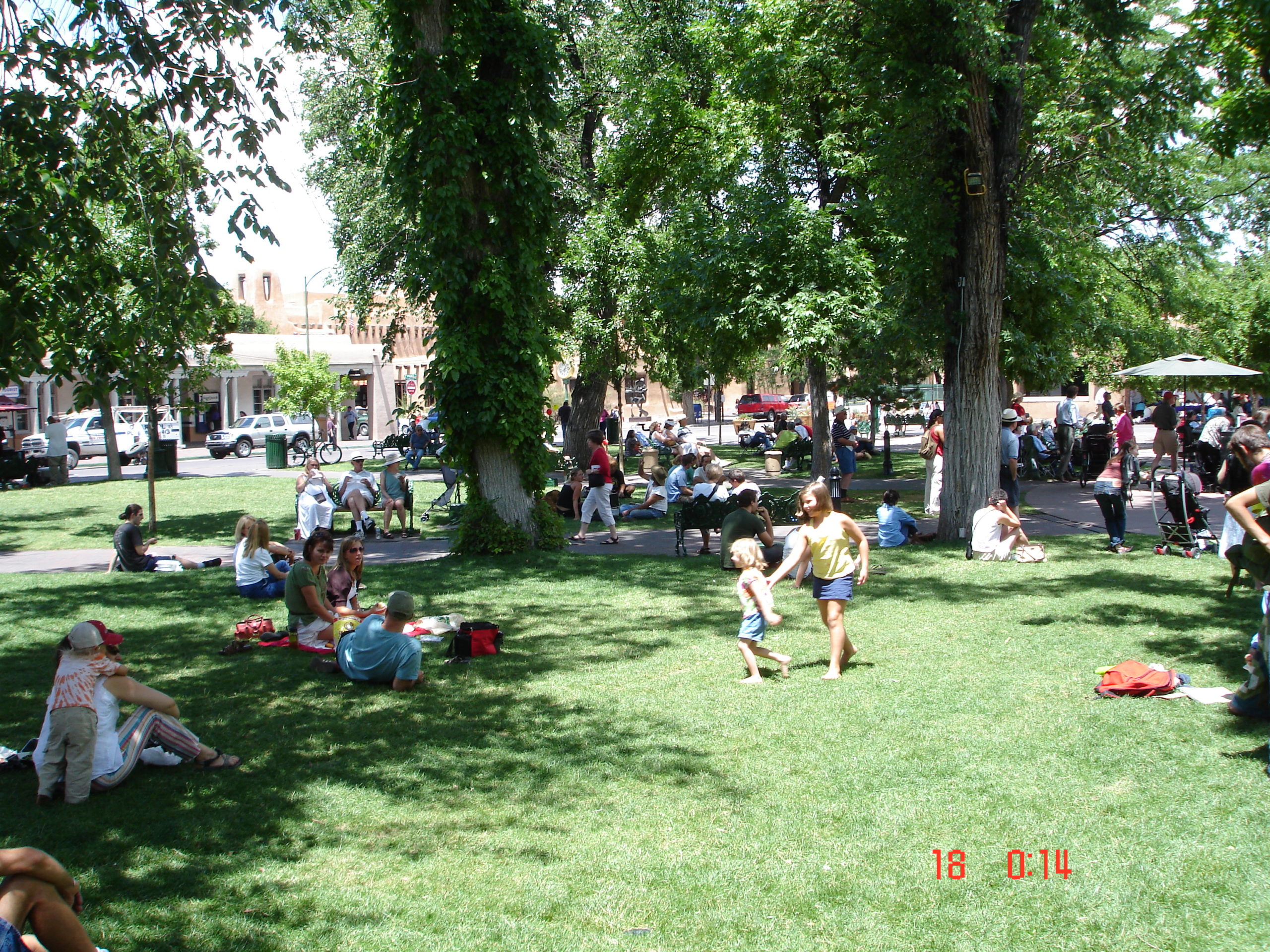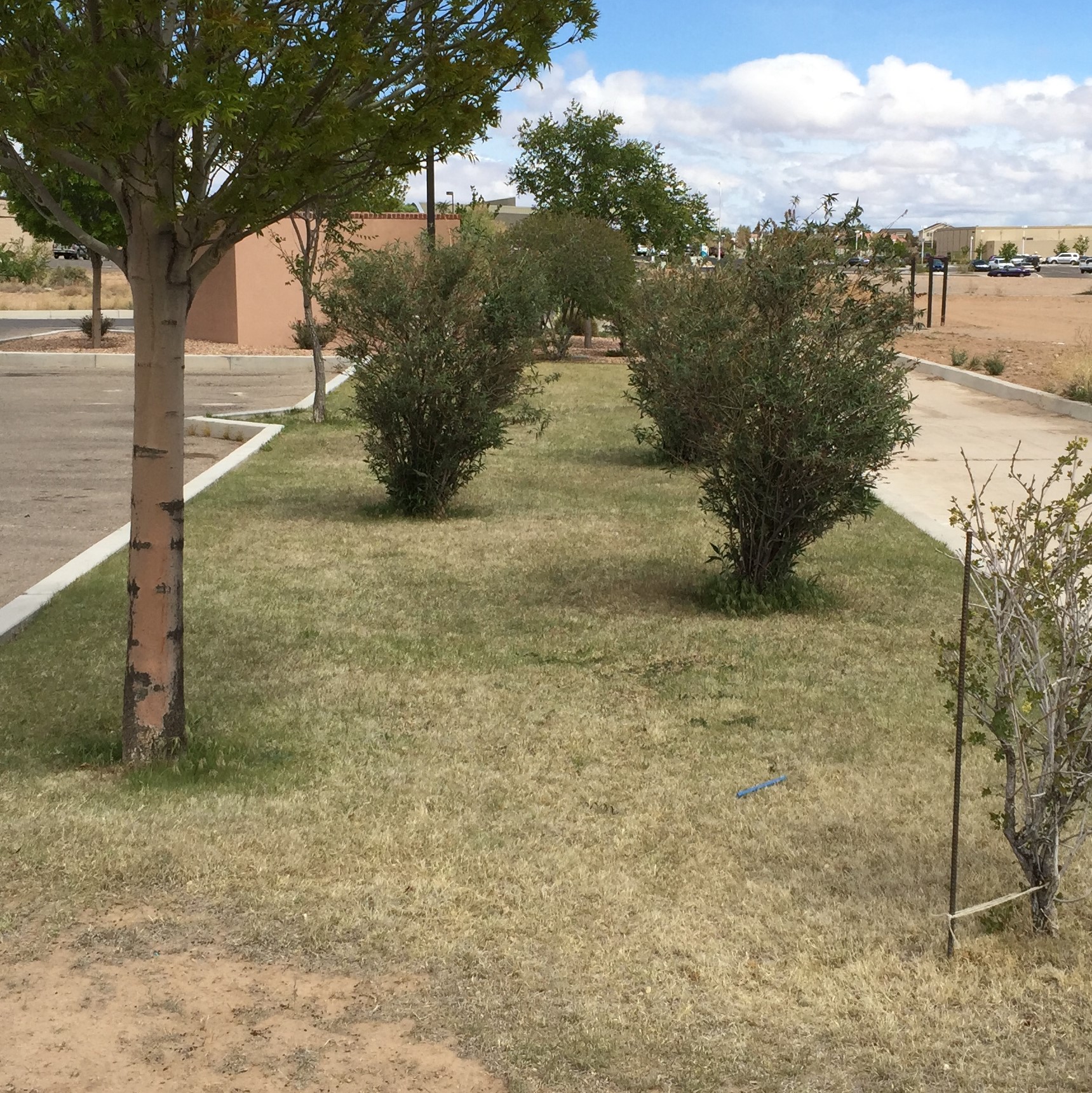Southwest Yard & Garden – Turfgrass Water Requirements and Water Conservation

by guest writer Dr. Bernd Leinauer, NMSU Extension Turfgrass Specialist

Kentucky bluegrass lawn in a Santa Fe park. Photo credit Bernd Leinauer.
Question: Our small lawn looks great and gets lots of use by the kids and dogs, but I wonder if we’re irrigating too much and if we can scale back to conserve water without damage. Should we switch to a different turfgrass species? – Concerned Lawn Owner, Albuquerque
Answer: The water requirements of most turfgrasses and other herbaceous plants used in New Mexico’s residential urban landscapes exceed natural rainfall amounts, and therefore supplemental irrigation is needed to keep them alive. In summer, outdoor watering accounts for up to 70% of urban domestic water use, and turfgrasses, which can make up a large portion of our landscapes, are identified as “water guzzlers.” However, our standard cool-season turfgrasses, such as Kentucky bluegrass, perennial ryegrass, and tall fescue, are the only groundcovers available that are cold-tolerant, traffic-tolerant, and aesthetically pleasing most of the year, all criteria that most homeowners require for their lawns. If traffic tolerance is not important, cold-tolerant warm-season grasses with lower irrigation requirements, such as buffalograss and blue grama, are recommended.
 Buffalograss turf planted in an Albuquerque median in mid-May. Photo credit Bernd Leinauer.
Buffalograss turf planted in an Albuquerque median in mid-May. Photo credit Bernd Leinauer.
You may have noticed that I avoid using the term “water use” and instead prefer “irrigation requirement.” Water use of turfgrasses is not a static number and is first and foremost a function of how much water is available in the soil; only secondarily do plant genetics play a role. Therefore, after an irrigation event, when soil pores are filled with water, turfgrasses will “consume” or “use” more than what is needed to survive and function. This phenomenon is called luxury consumption. Studies have shown that under such circumstances actual water use of buffalograss, a grass known for its lower irrigation requirements, is similar to that of Kentucky bluegrass. Luxury consumption is the result of over-irrigation, a common occurrence among many homeowners who are unaware of how much water is applied during irrigation events, or how much water is truly required to maintain their turfgrass areas at acceptable levels.
A good estimate of the amount of water your lawn requires is the amount that has been lost due to transpiration from the plant and evaporation from the soil. The combined loss is called evapotranspiration or ET (evaporation + transpiration). New Mexico State University’s climatologist Dr. Dave DuBois operates climate stations around the state that are accessible online (http://weather.nmsu.edu), and data can be downloaded for free. The NMSU climate station closest to Albuquerque for calculating ET is in Los Lunas. Alternatively, there are agencies that provide historic ET numbers online by simply entering your zip code (for example http://www.rainmaster.com/historicET.aspx). Please note: This particular website is reporting average daily ET values for each month of the year, not monthly totals. Additionally, it is unclear if numbers from website tools like this are as accurate as the ones with data obtained locally from on-site climate stations, but they are certainly a good start in determining irrigation requirements.
For the week of April 26 to May 2, the Los Lunas climate station data list air temperatures of around 90°F and daily ET of approximately 0.2 inch. Cumulative ET for the entire week was 1.44 inches. It is also important to know that most turfgrasses can tolerate irrigation amounts lower than a 100% ET replacement rate. For cool-season grasses, we recommend that at least 80% of ET be used for irrigation and for warm-season grasses 60 to 70% of ET. So, for the week of April 26 in Los Lunas and surrounding areas, cool-season grasses required approximately 1.15 inches to meet 80% of ET and warm-season grasses required slightly less (0.86–1.0 inch).
If your lawn is irrigated from a pop-up sprinkler system and you are confident that your system has been installed and is maintained correctly, you can look up your sprinkler and nozzle type and obtain precipitation or output rates from the specification sheets. A very common sprinkler used in lawns is Hunter’s MP Rotator with a precipitation rate of approximately 0.4 inch per hour. A more accurate way to determine your system’s output and efficiency would be to conduct an irrigation audit, but we will cover this topic in a future column. If the lawn requires 80% of daily ET and you’ve confirmed that 0.2 inch/day is the current daily ET in your area, that totals 0.16 inch needed daily. If your system puts out 0.4 inch/hour, your sprinkler system will have to run for approximately 25 minutes per day. From a water use perspective, it makes no difference whether you irrigate 25 minutes per day or 50 minutes every second day. Some municipalities only permit homeowners to irrigate three times a week, which would amount to a run time of 56 minutes at each irrigation to meet your weekly ET demand in this example.
These calculations assume that you have a uniform irrigation system that covers all areas of your lawn with equal amounts of water. However, this is usually not the case, and our research has shown that a significant amount of water is wasted because of poorly operating sprinkler systems. Based on our findings, more water can be saved by installing and maintaining a uniform irrigation system than by replacing cool-season with warm-season grasses while operating the old system. The biggest bang for your buck in water conservation comes from having a uniform irrigation system.
Our research has also shown that grasses irrigated daily with the appropriate ET rate are greener and healthier than grasses irrigated only three times a week but receiving the same amount on a weekly basis. These findings certainly go against the common recommendations of “heavy and infrequent rather than light and frequent irrigations.” There are several reasons why irrigating lawns daily is advantageous over irrigating only three times a week. First, irrigating every second or third day requires relatively long run times and larger outputs of water compared to irrigating daily. A portion of the water moves through the soil to depths at which roots no longer grow and this water is lost. Second, if the irrigation system has poor uniformity, water may not infiltrate into the soil but is lost through runoff, puddling, and evaporation. Again this is water that is lost and not plant-available. Third, larger volumes of water will saturate the soil to a larger degree and result in luxury consumption, meaning the plants will use more water than is needed.
If you want to enjoy a healthy lawn while also taking water conservation seriously, I recommend the following: Learn how much water is applied with every irrigation and find out if it matches the ET requirement in your area. Conduct an irrigation audit to find out if your system operates uniformly and efficiently. Visit https://aces.nmsu.edu/pubs/_h/#lawns for several NMSU Extension publications on lawn care for New Mexico, including how to perform your own irrigation audit.
If you feel you are wasting water by irrigating your lawn, start watering less. Within several days, you will reach a point when the turf’s visual appearance declines somewhat, but this slight decline in appearance may be acceptable. If you have a small and irregularly shaped area that is very hard to irrigate from a sprinkler system, consider a subsurface drip system. After several years of research, we have concluded that Kentucky bluegrass is more drought-tolerant than all other cool-season grasses and should be recommended if a cool-season grass is chosen. Use warm-season grasses, such as zoysiagrass, bermudagrass, buffalograss, and blue grama, if you are looking to reduce water use even further and feel a change in species will not affect the purpose and functionality of your lawn.
Guest author Dr. Bernd Leinauer (NMSU Extension Turfgrass Specialist, @NuMex_Turf) is based in Las Cruces and performs research in turfgrass water conservation. Regular author Dr. Marisa Thompson (NMSU Extension Horticulture Specialist) is based at the NMSU Agricultural Science Center at Los Lunas.
For more gardening information, including decades of archived Southwest Yard & Garden columns, visit the NMSU Extension Horticulture page (http://desertblooms.nmsu.edu/), follow us on social media (@NMDesertBlooms), or contact your County Extension office (https://aces.nmsu.edu/county).
